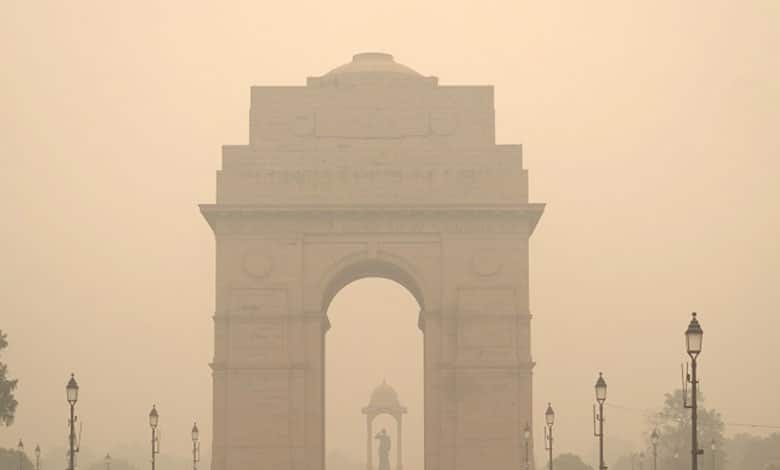Delhi’s Air Quality Improves to ‘Moderate’ After Record-Breaking Rainfall
"Discover how record-breaking rainfall improved Delhi's air quality to 'moderate' levels, offering temporary relief from winter pollution. Learn about AQI trends, weather impacts, and long-term solutions."

New Delhi: Delhi’s air quality witnessed a significant improvement, shifting to the ‘moderate’ category on Monday, following record-breaking rainfall between Friday and Saturday.
The downpour provided much-needed respite to the residents of the capital, which frequently grapples with hazardous pollution levels, especially during the winter months.
Table of Contents
AQI Levels Show Improvement
As of 6 a.m. on Monday, the overall Air Quality Index (AQI) in Delhi stood at 183, marking an improvement from the previous days. The AQI is categorized by the Central Pollution Control Board (CPCB) as follows:
- 0-50: Good
- 51-100: Satisfactory
- 101-200: Moderate
- 201-300: Poor
- 301-400: Very Poor
- 401-450: Severe
- Above 450: Severe Plus
Out of 38 monitoring stations in Delhi listed on the Sameer app, 23 recorded AQI in the moderate range. Notably, the IHBAS station in Dilshad Garden reported a ‘satisfactory’ AQI of 95, offering a rare moment of relief.
Record Rainfall Brings Relief
The heavy rainfall recorded over the weekend played a pivotal role in cleansing the air. According to the India Meteorological Department (IMD), Delhi experienced its highest single-day December rainfall in 101 years, with 41.2 mm recorded in the 24 hours leading up to 8:30 a.m. on Saturday. The all-time December record for single-day rainfall stands at 75.7 mm, set on December 3, 1923.
This unprecedented rainfall also made December 2024 the fifth-highest month in terms of rainfall since record-keeping began in 1901. The IMD attributed the rain and accompanying thunderstorms to an active western disturbance interacting with easterly winds over northwest and central India, including the Delhi-NCR region.
Temperature Trends
Delhi’s weather also reflected the impact of this rainfall. The maximum temperature on Sunday was recorded at 18°C, which is two degrees below the seasonal norm. The minimum temperature stood at 13°C, six notches above the average for late December.
Air Quality Fluctuations Expected in Winter
While the improvement in AQI to the ‘moderate’ range offers temporary relief, experts warn that pollution levels could spike again as winter progresses. Historical data indicates that Delhi’s air quality typically deteriorates in the colder months due to multiple factors:
- Stubble Burning: Farmers in neighboring states burn crop residue, releasing significant pollutants into the atmosphere.
- Vehicular Emissions: Increased vehicle usage contributes to particulate matter and gaseous pollutants.
- Heating Fuels: The use of solid fuels like wood and coal for heating during winter months exacerbates air pollution.
- Weather Conditions: Lower wind speeds, temperature inversions, and increased humidity often trap pollutants close to the ground, worsening air quality.
Role of Winds in Pollution Dispersion
Wind patterns are a crucial determinant of Delhi’s air quality. Strong winds help disperse pollutants, resulting in improved air quality. However, a reduction in wind speed or a shift in weather patterns can quickly lead to pollution buildup.
Also Read | Dense Fog and ‘Very Poor’ Air Quality Disrupt Delhi: Flights, Trains Delayed
Health Advisory
Even with an AQI in the ‘moderate’ category, residents are advised to remain cautious. Vulnerable groups, including children, the elderly, and individuals with respiratory conditions, should take the following precautions:
- Avoid prolonged outdoor activities during peak pollution hours.
- Use air purifiers indoors to maintain healthy air quality.
- Wear protective masks if stepping outdoors for extended periods.
Long-Term Solutions for Cleaner Air
Addressing Delhi’s air pollution problem requires concerted efforts from both authorities and citizens. Key measures include:
- Promoting Cleaner Fuels: Transitioning to cleaner energy sources for vehicles and heating.
- Enhancing Public Transport: Encouraging the use of public transportation and reducing vehicular emissions.
- Better Waste Management: Preventing open waste burning that releases harmful toxins.
- Afforestation Efforts: Increasing green cover to naturally filter pollutants from the air.
